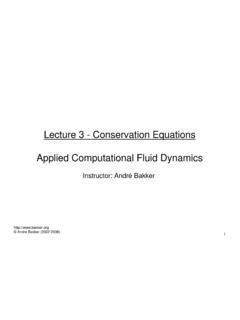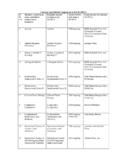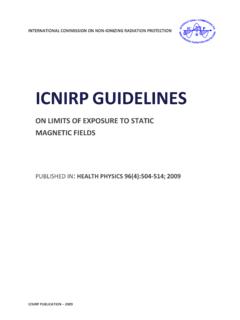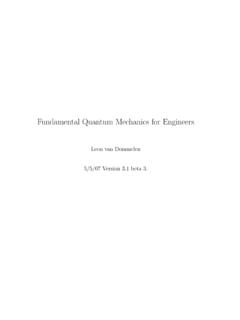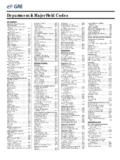Transcription of PARTICLE PHYSICS - issp.ac.ru
1 PARTICLE PHYSICS Edited by Eugene Kennedy PARTICLE PHYSICS Edited by Eugene Kennedy Published by InTech Janeza Trdine 9, 51000 Rijeka, Croatia Copyright 2012 InTech All chapters are Open Access distributed under the Creative Commons Attribution license, which allows users to download, copy and build upon published articles even for commercial purposes, as long as the author and publisher are properly credited, which ensures maximum dissemination and a wider impact of our publications. After this work has been published by InTech, authors have the right to republish it, in whole or part, in any publication of which they are the author, and to make other personal use of the work. Any republication, referencing or personal use of the work must explicitly identify the original source. As for readers, this license allows users to download, copy and build upon published chapters even for commercial purposes, as long as the author and publisher are properly credited, which ensures maximum dissemination and a wider impact of our publications.
2 Notice Statements and opinions expressed in the chapters are these of the individual contributors and not necessarily those of the editors or publisher. No responsibility is accepted for the accuracy of information contained in the published chapters. The publisher assumes no responsibility for any damage or injury to persons or property arising out of the use of any materials, instructions, methods or ideas contained in the book. Publishing Process Manager Vana Persen Technical Editor Teodora Smiljanic Cover Designer InTech Design Team First published April, 2012 Printed in Croatia A free online edition of this book is available at Additional hard copies can be obtained from PARTICLE PHYSICS , Edited by Eugene Kennedy p. cm. ISBN 978-953-51-0481-0 Contents Preface VII Chapter 1 The Generation Model of PARTICLE PHYSICS 1 Brian Robson Chapter 2 Constraining the Couplings of a Charged Higgs to Heavy Quarks 29 A.
3 S. Cornell Chapter 3 Introduction to Axion Photon Interaction in PARTICLE PHYSICS and Photon Dispersion in Magnetized Media 49 Avijit K. Ganguly Chapter 4 The e-Science Paradigm for PARTICLE PHYSICS 75 Kihyeon Cho Chapter 5 Muon Colliders and Neutrino Effective Doses 91 Joseph John Bevelacqua Preface Interest in PARTICLE PHYSICS continues apace. With the Large Hadron Collider showing early tantalizing glimpses of what may yet prove to be the elusive Higgs Boson, PARTICLE PHYSICS remains a fertile ground for creative theorists. While the Standard model of PARTICLE PHYSICS remains hugely successful, nevertheless it is still not fully regarded as a complete holistic description. This book describes the development of what is termed the generation model, which is proposed as an alternative to the standard model and provides a new classification approach to fundamental particles . A further chapter describes an extension to the standard model involving the possibility of a charged Higgs boson and includes an outline of how experimental evidence may be sought at LHC and B factory facilities.
4 Coupling of postulated axion particles to photons is tackled with particular reference to magnetized media, together with possible implications for detection in laboratory experiments or astrophysical observations. Modern PARTICLE PHYSICS now involves major investments in hardware coupled with large scale theoretical and computational efforts. The complexity of such synergistic coordinated entities is illustrated within the framework of the e science paradigm. Finally, an unexpected and interesting description of the potential radiation hazards associated with extremely weakly interacting neutrinos is provided in the context of possible future designs of intense muon collider facilities. Eugene Kennedy Emeritus Professor School of Physical Sciences, Dublin City University Ireland 1. IntroductionThe main purpose of this chapter is to present an alternative to the Standard Model (SM)(Gottfried and Weisskopf, 1984) of PARTICLE PHYSICS .
5 This alternative model, called theGeneration Model (GM) (Robson, 2002; 2004; Evans and Robson, 2006), describes all thetransition probabilities for interactions involving the six leptons and the six quarks, whichform the elementary particles of the SM in terms of only three unified additive quantumnumbers instead of the nine non-unified additive quantum numbers allotted to the leptonsand quarks in the chapter presents (Section 2) an outline of the current formulation of the SM: theelementary particles and the fundamental interactions of the SM, and the basic probleminherent in the SM. This is followed by (Section 3) a summary of the GM, highlighting theessential differences between the GM and the SM. Section 3 also introduces a more recentdevelopment of a composite GM in which both leptons and quarks have a enhanced GM has been named the Composite Generation Model (CGM) (Robson, 2005;2011a). In this chapter, for convenience, we shall refer to this enhanced GM as the CGM,whenever the substructure of leptons and quarks is important for the discussion.
6 Section 4focuses on several important consequences of the different paradigms provided by the particular: the origin of mass, the mass hierarchy of the leptons and quarks, the origin ofgravity and the origin of apparent CP violation, are discussed. Finally, Section 5 provides asummary and discusses future Standard model of PARTICLE physicsThe Standard Model (SM) of PARTICLE PHYSICS (Gottfried and Weisskopf, 1984) was developedthroughout the 20th century, although the current formulation was essentially finalized in themid-1970s following the experimental confirmation of the existence of quarks (Bloomet al.,1969; Breidenbachet al., 1969).The SM has enjoyed considerable success in describing the interactions of leptons and themultitude of hadrons (baryons and mesons) with each other as well as the decay modes of theunstable leptons and hadrons. However the model is considered to be incomplete in the sensethat it provides no understanding of several empirical observations such as: the existenceof three families or generations of leptons and quarks, which apart from mass have similarproperties; the mass hierarchy of the elementary particles , which form the basis of the SM; thenature of the gravitational interaction and the origin of CP violation.
7 The Generation Model of PARTICLE PHYSICS Brian Robson Department of Theoretical PHYSICS , Research School of PHYSICS and Engineering, The Australian National University, Canberra Australia 12 Will-be-set-by-IN-TECHIn this section a summary of the current formulation of the SM is presented: the elementaryparticles and the fundamental interactions of the SM, and then the basic problem inherent inthe Elementary particles of the SMIn the SM the elementary particles that are the constituents of matter are assumed to be thesix leptons: electron neutrino ( e), electron (e ), muon neutrino ( ), muon ( ), tau neutrino( ), tau ( ) and the six quarks: up (u), down (d), charmed (c), strange (s), top (t) and bottom(b), together with their antiparticles. These twelve particles are all spin-12particles and fallnaturally into three families or generations: (i) e,e ,u,d; (ii) , ,c,s; (iii) , ,t, generation consists of two leptons with chargesQ=0 andQ= 1 and two quarks withchargesQ=+23andQ= 13.
8 The masses of the particles increase significantly with eachgeneration with the possible exception of the neutrinos, whose very small masses have yet tobe the SM the leptons and quarks are allotted several additive quantum numbers: chargeQ, lepton numberL, muon lepton numberL , tau lepton numberL , baryon numberA,strangenessS, charmC, bottomnessBand topnessT. These are given in Table 1. Foreach PARTICLE additive quantum numberN, the corresponding antiparticle has the additivequantum number L ASCBT e01 0 0 00000e 11 0 0 0 0 0 0 0 01 1 0 00000 11 1 0 0 0 0 0 0 01 0 1 00000 11 0 1 0 0 0 0 0u+2300 0130000d 1300 0130000c+2300 0130100s 1300 013 10 0 0t+2300 0130001b 1300 01300 10 Table 1. SM additive quantum numbers for leptons and quarksTable 1 demonstrates that, except for charge, leptons and quarks are allotted different kindsof additive quantum numbers so that this classification of the elementary particles in the additive quantum numbersQandAare assumed to be conserved in strong,electromagnetic and weak interactions.
9 The lepton numbersL,L andL are not involved instrong interactions but are strictly conserved in both electromagnetic and weak remainder,S,C,BandTare strictly conserved only in strong and electromagneticinteractions but can undergo a change of one unit in weak quarks have an additional additive quantum number called color charge", which cantake three values so that in effect we have three kinds of each quark,u,d, etc. These are often2 PARTICLE PhysicsThe Generation Model of PARTICLE Physics3called red, green and blue quarks. The antiquarks carry anticolors, which for simplicity arecalled antired, antigreen and antiblue. Each quark or antiquark carries a single unit of color oranticolor charge, respectively. The leptons do not carry a color charge and consequently do notparticipate in the strong interactions, which occur between particles carrying color Fundamental interactions of the SMThe SM recognizes four fundamental interactions in nature: strong, electromagnetic, weakand gravity.
10 Since gravity plays no role in PARTICLE PHYSICS because it is so much weaker thanthe other three fundamental interactions, the SM does not attempt to explain gravity. In theSM the other three fundamental interactions are assumed to be associated with a local Strong interactionsThe strong interactions, mediated by massless neutral spin-1 gluons between quarks carryinga color charge, are described by anSU(3)local gauge theory called quantum chromodynamics(QCD) (Halzen and Martin, 1984). There are eight independent kinds of gluons, each of whichcarries a combination of a color charge and an anticolor charge ( red-antigreen). The stronginteractions between color charges are such that in nature the quarks (antiquarks) are groupedinto composites of either three quarks (antiquarks), called baryons (antibaryons), each havinga different color (anticolor) charge or a quark-antiquark pair, called mesons, of opposite colorcharges. In theSU(3)color gauge theory each baryon, antibaryon or meson is , these colorless particles , called hadrons, may interact strongly via residual stronginteractions arising from their composition of colored quarks and/or antiquarks.
